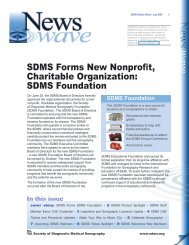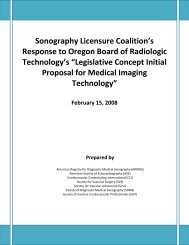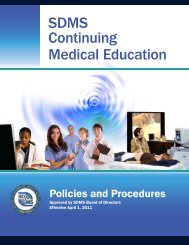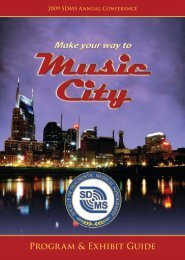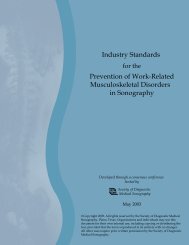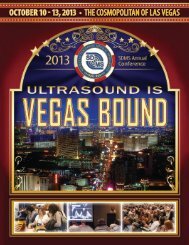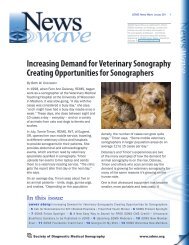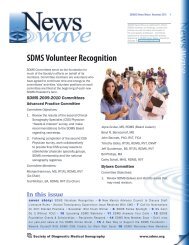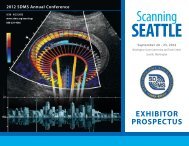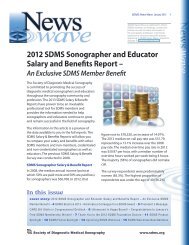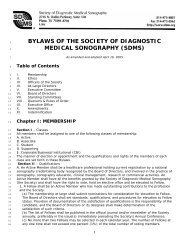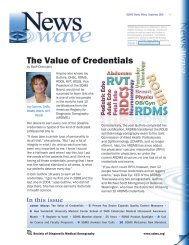Ultrasound Doppler of the Liver & Portal Hypertension
Ultrasound Doppler of the Liver & Portal Hypertension
Ultrasound Doppler of the Liver & Portal Hypertension
You also want an ePaper? Increase the reach of your titles
YUMPU automatically turns print PDFs into web optimized ePapers that Google loves.
<strong>Ultrasound</strong> <strong>Doppler</strong><br />
<strong>of</strong> <strong>the</strong> <strong>Liver</strong> & <strong>Portal</strong> <strong>Hypertension</strong><br />
Myron A. Pozniak, MD<br />
Pr<strong>of</strong>essor <strong>of</strong> fRadiology<br />
University <strong>of</strong> Wisconsin<br />
Madison, Wisconsin<br />
Objectives:<br />
Review <strong>the</strong> normal hepatic <strong>Doppler</strong> flow pr<strong>of</strong>iles<br />
Recognize e <strong>the</strong> hemodynamic changes <strong>of</strong> portal<br />
hypertension<br />
Recognize <strong>the</strong> common and unusual pathways <strong>of</strong><br />
porto-systemic shunting<br />
Hepatic artery<br />
• Normal waveform<br />
• Brisk upstroke in<br />
systole<br />
• RI 60-70%<br />
• Diastolic velocity<br />
<strong>Portal</strong> vein normal flow<br />
• Relatively uniform velocity.<br />
Some periodicity OK.<br />
• But not too much<br />
• Velocity just under<br />
20 cm/sec<br />
in a fasting patient<br />
The liver vascular index<br />
• Relationship <strong>of</strong> portal vein velocity to hepatic artery velocity<br />
The liver vascular index<br />
• Relationship <strong>of</strong> portal vein velocity to hepatic artery velocity<br />
2
Hepatic Vein Anatomy<br />
Hepatic Vein Anatomy<br />
Hepatic vein laminar flow dynamics<br />
3
Venous waveform terminology<br />
• Pulsatility<br />
• Periodicity<br />
• Phasicity<br />
Hepatic Vein Flow Dynamics<br />
Hep Vein<br />
Velocity<br />
Tracing<br />
A<br />
C<br />
S<br />
V<br />
D<br />
ECG<br />
Tricuspid<br />
M-Mode<br />
Back to <strong>the</strong> Porta Hepatis<br />
Altered flow pr<strong>of</strong>iles<br />
4
Altered porta-hepatis hemodynamics<br />
Increased Periodicity <strong>of</strong> <strong>Portal</strong> vein flow<br />
Altered porta-hepatis hemodynamics<br />
Increased Periodicity <strong>of</strong> <strong>Portal</strong> vein flow<br />
• May be due to<br />
hyperdynamic<br />
arterial ilifl inflow<br />
• May be secondary<br />
to increased<br />
retropulsation with<br />
cardiac disease<br />
Altered porta-hepatis hemodynamics<br />
Increased Periodicity <strong>of</strong> <strong>Portal</strong> vein flow<br />
•<strong>Liver</strong> disease<br />
•AV fistula<br />
•Cardiac issues<br />
•Tricuspid regurgitation<br />
•Right ventricular dysfunction<br />
5
Normal hepatic blood flow<br />
• 25% <strong>of</strong> cardiac output<br />
• 1.5 Liters per minute<br />
• <strong>Portal</strong> inflow 2/3; arterial inflow 1/3<br />
• 90% <strong>of</strong> Oxygen via Hepatic Artery<br />
• The Artery supplies <strong>the</strong> disease process.<br />
The altered liver vascular index<br />
}<br />
Increased hepatic arterial flow / Decreased portal vein flow<br />
Altered porta-hepatis hemodynamics<br />
• Verifies <strong>the</strong> “starry sky” liver as abnormal<br />
6
The altered liver vascular index<br />
• Initially reported to be highly sensitive and specific for<br />
diagnosis <strong>of</strong> Hepatocellular Carcinoma (HCC)<br />
• Many o<strong>the</strong>r causes<br />
Iwao T, et al. Value <strong>of</strong> <strong>Doppler</strong> ultrasound parameters <strong>of</strong> portal vein and hepatic artery in<br />
<strong>the</strong> diagnosis <strong>of</strong> cirrhosis and portal hypertension. Am J Gastroenterol 1997;92:1012-1017.<br />
Altered porta-hepatis hemodynamics<br />
• Diffuse hepatocellular disorder<br />
• Hepatitis – viral, chemical, alcoholic<br />
• Focal lesions<br />
• Lymphoma<br />
• Metastatic disease<br />
• Hepatitis<br />
• Etc.<br />
• Non-specific<br />
• It’s not really compensatory<br />
Nomenclature<br />
• Normal portal flow is hepatopetal<br />
• Not –pedal<br />
• Reversed portal flow is hepat<strong>of</strong>ugal<br />
• As in: centrifugal force / centripetal force<br />
7
The degree <strong>of</strong> PV flow reversal correlates<br />
with <strong>the</strong> severity <strong>of</strong> <strong>the</strong> liver disease.<br />
Except in <strong>the</strong> presence <strong>of</strong> a paraumbilical vein<br />
Resistance to inflow may result in relative<br />
<strong>Portal</strong> Vein stasis.<br />
PV flow reversible with Valsalva<br />
8
<strong>Portal</strong> hypertension<br />
• Increased pressure gradient between <strong>the</strong> portal vein<br />
and <strong>the</strong> IVC above 6 mmHg<br />
• >6 mmHg 12 mmHg (clinically evident)<br />
18<br />
12<br />
6<br />
0<br />
Hepatic Vascular Anatomy<br />
<strong>Portal</strong> Triad<br />
9
Hepatic Vascular Anatomy<br />
<strong>Portal</strong> Triad<br />
Classifications <strong>of</strong> portal hypertension<br />
• Pre-sinusoidal<br />
• Sinusoidal<br />
• Post-sinusoidalsinusoidal<br />
X<br />
X<br />
X<br />
Pre-sinusoidal<br />
• Extrahepatic<br />
• <strong>Portal</strong> vein obstruction<br />
• compression<br />
• occlusion<br />
• Arterio-portal fistula<br />
• Intrahepatic<br />
• Fibrosis<br />
• Wilson disease<br />
• Sarcoid<br />
• Parasites<br />
X<br />
X<br />
X<br />
10
Sinusoidal<br />
• Cirrhosis<br />
• Laennec<br />
• Hepatitis<br />
• Sclerosing cholangitis<br />
X X X X<br />
X X X<br />
Post-sinusoidal - Budd Chiari Syndrome<br />
• Hepatic vein<br />
thrombosis<br />
• Hepatic venous<br />
outflow<br />
obstruction<br />
• Cardiac<br />
• Pulmonary<br />
X<br />
X<br />
X<br />
Clinical Presentation Depends on Severity <strong>of</strong> Disease<br />
• Elevated <strong>Liver</strong> Enzymes<br />
• <strong>Ultrasound</strong> is usually <strong>the</strong> 1 st imaging test<br />
• You must perform (request) <strong>Doppler</strong><br />
11
With Hepatocellular disease…<br />
• <strong>Portal</strong> flow decreases<br />
• Arterial flow increases<br />
(early in <strong>the</strong> disease<br />
process)<br />
Reversed PV flow<br />
Where is this blood coming from?<br />
Eventually <strong>the</strong> disease worsens to <strong>the</strong> point that<br />
even Hepatic Artery flow encounters resistance.<br />
• It finds a path with less resistance …<br />
• The portal vein<br />
The portal vein<br />
• The end result is…<br />
• Hepat<strong>of</strong>ugal flow<br />
12
Imaging findings <strong>of</strong> portal hypertension<br />
• <strong>Portal</strong> vein<br />
enlargement<br />
• Decreased or<br />
reversed flow<br />
• Varices<br />
Portosystemic pathways<br />
• Gastrosplenic (short gastric)<br />
• Left gastric<br />
• Recanalized umbilical vein<br />
• Splenorenal<br />
l<br />
• Mesenteric<br />
• Retroperitoneal<br />
• Hemorrhoidal<br />
Identification and mapping <strong>of</strong> varicees …<br />
• helps avoid surgical complications<br />
• helps in planning transplant surgery<br />
• Helps in planning TIPS<br />
13
3D CT angiography <strong>of</strong> portal hypertension<br />
• Augment perception <strong>of</strong> <strong>the</strong> entire collateral<br />
pathway<br />
• 150 cc <strong>of</strong> contrast at 5 cc/sec<br />
150 cc <strong>of</strong> contrast at 5 cc/sec<br />
• Imaging during arterial and portal venous phases<br />
• 3D reformatting with subtraction<br />
14
42 y/o liver transplant candidate<br />
Short Gastric Varix<br />
Both Short and Left Gastric Varicees<br />
15
55 y/o liver transplant candidate<br />
Both Short and Left Gastric Varices<br />
Short Gastric Varix<br />
Left Gastric Varix<br />
16
Esophageal varix<br />
Left Gastric Varix<br />
The <strong>Doppler</strong> window to <strong>the</strong>….<br />
Left gastric varix<br />
Short gastric varix<br />
17
Paraumbilical vein<br />
Recanalized umbilical vein<br />
When it arrives at <strong>the</strong> umbilicus, it is still not back to <strong>the</strong> systemic circulation<br />
Recanalized umbilical vein<br />
Drainage pathways<br />
• Caput medusae<br />
• Inferior epigastric to external iliac<br />
• Superficial circumflex iliac vein<br />
• Substernal veins<br />
• Anywhere it can<br />
IVC<br />
Paraumbilical<br />
Inferior epigastric<br />
External iliac<br />
18
Funny things can happen at <strong>the</strong> umbilicus.<br />
32 y/o prisoner with an umbilical hernia<br />
19
DO NOT biopsy this!<br />
Varices may complicate <strong>the</strong> surgical<br />
approach to underlying pathology<br />
52 y/o female with LLQ pain, fever, elevated white<br />
count<br />
• Clinical diagnosis - diverticulitis<br />
Clinical diagnosis diverticulitis<br />
• Past medical history<br />
• <strong>Liver</strong> disease<br />
• <strong>Portal</strong> hypertension - Apparently resolved<br />
20
Pericholecystic varices<br />
• Rare<br />
• Commonly associated with portal vein thrombosis<br />
21
Spleno-renal Collateral<br />
S<br />
K<br />
Spleno-renal Collateral<br />
22
Spleno-renal varices are rarely direct<br />
They <strong>of</strong>ten involve <strong>the</strong> gonadal vein.<br />
… or a mesenteric vein<br />
Spleno-renal-mesenteric collateral<br />
pathways can be very convoluted<br />
Spleno-external-iliac collateral (via <strong>the</strong> panus)<br />
23
39 y/o female with pelvic<br />
mass on physical exam<br />
<strong>Portal</strong> <strong>Hypertension</strong><br />
• Variceal pathways can be just about anywhere<br />
Not all portal system varices are due to<br />
portal hypertension.<br />
24
Isolated gastric varix due to<br />
splenic vein thrombosis.<br />
Not all portal system varices are due to portal<br />
hypertension.<br />
Conclusions<br />
<strong>Portal</strong> <strong>Hypertension</strong><br />
• Variceal pathways can be just about anywhere.<br />
• Pre-transplant shunt identification is critical to<br />
transplant survival.<br />
• An unsuspected varix can ruin a good surgeon’s<br />
day<br />
25
Conclusions<br />
<strong>Portal</strong> hypertension (cont.)<br />
• They can be anywhere<br />
• When you think you have a cystic mass - don’t<br />
forget to turn on <strong>the</strong> <strong>Doppler</strong><br />
Conclusions<br />
• When <strong>the</strong> request says:<br />
“ELEVATED LIVER ENZYMES”<br />
• Don’t just think anatomy …<br />
• Think physiology … Hemodynamics<br />
Conclusions<br />
• Spectral and color <strong>Doppler</strong> add<br />
hemodynamic information to <strong>the</strong> imaging<br />
findings.<br />
26



